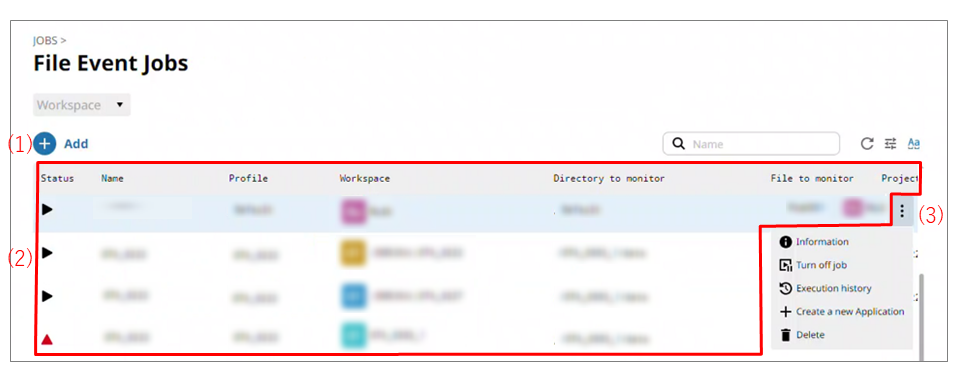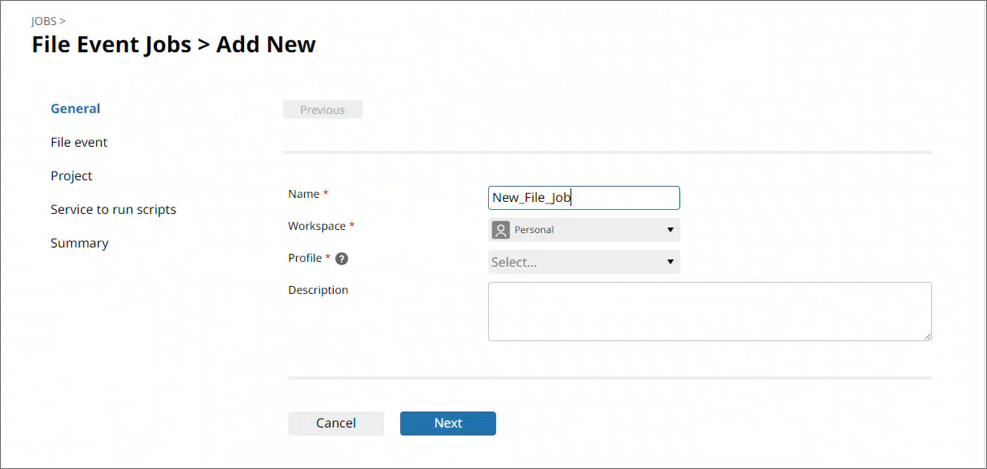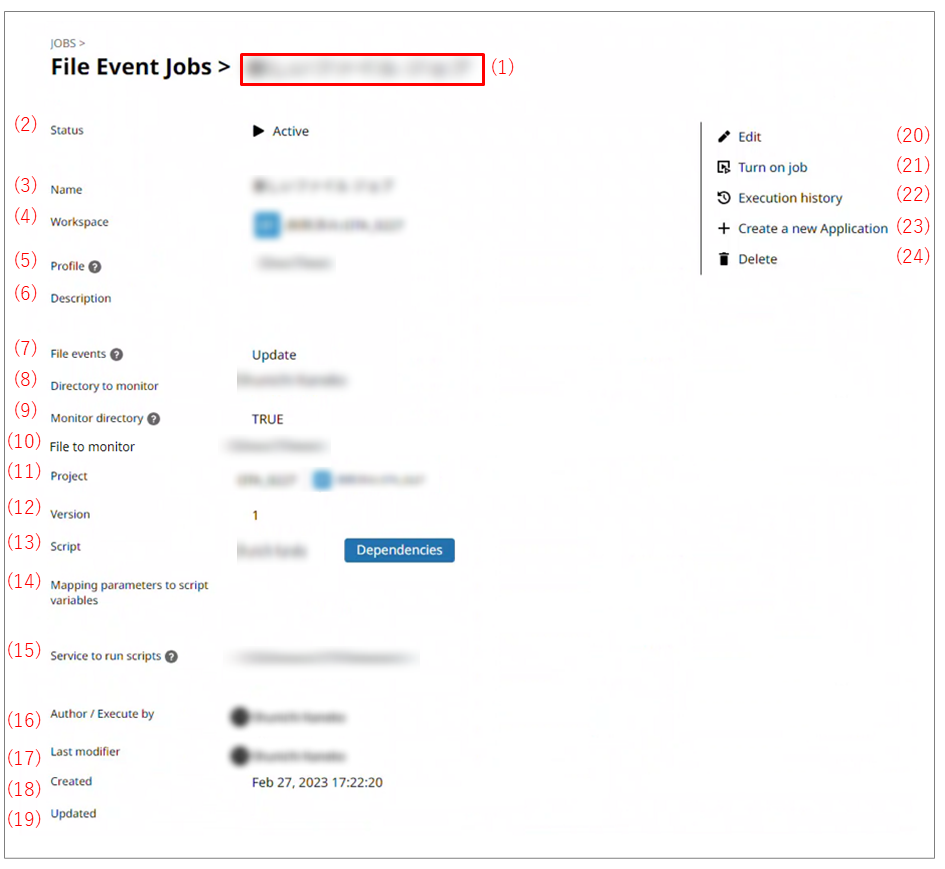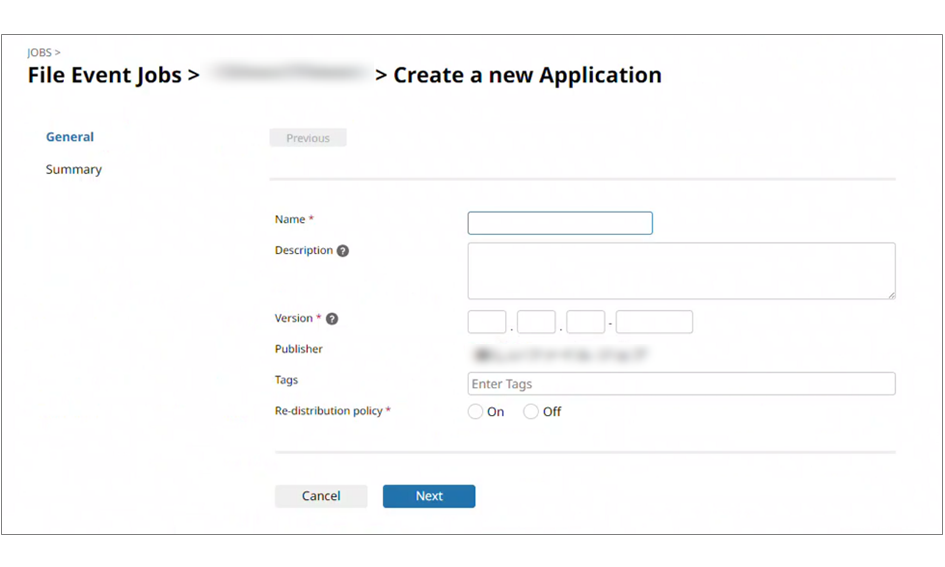File Event Jobs
On the File Event Jobs page in the Main category, you can create jobs to trigger the execution of a script by creation, update, and deletion of monitored files. To set file event jobs, select  > JOBS > File Event Jobs in the navigation menu.
> JOBS > File Event Jobs in the navigation menu.
The user who performs the operation that triggers the file event is displayed in Executed by.
Users can specify workspaces in file event jobs to share with other users or groups.
For more details about how to use workspaces to share settings, refer to Share settings with team members.
The key points about creating and setting file event jobs are explained in this section.
Tutorials
For the creation method for file event jobs, refer to the following tutorial:
Points for settings
To create a new file event job, select Add on the File Event Jobs page and specify information such as the file to monitor and the profile to use.
You can manage the execution of the created jobs by turning the jobs on and off.
This section explains the screen transitions from the File Event Jobs page and the operations for setting file event jobs.
For the names and functions of basic UI elements and other items of HULFT Square, refer to the following topic:
File Event Jobs
In the navigation menu, select  > JOBS > File Event Jobs to open this page.
> JOBS > File Event Jobs to open this page.
On the File Event Jobs page, you can manage your file event jobs by performing the following operations:
-
Viewing detailed information about jobs
-
Turning jobs on and off
-
Showing execution history for jobs
-
Creating new applications
-
Deleting jobs

- (1) Add
-
Select this icon to create a new file event job.
For the screen displayed after selecting this icon, refer to File Event Jobs > Add New.
- (2) List of settings
-
File event jobs that have already been created are displayed in tabular form.
The status is indicated as follows:

:
This icon indicates that the file event job is running.

:
This icon indicates that the file event job is suspended.
To run or suspend a file event job, select Turn on/off job from the action menu.
= Remarks =You can register more than 5,000 file event jobs, but the maximum number displayed for each workspace is 5,000. If you select multiple workspaces, the amount over 5,000 isn't displayed.
- (3) Action menu
-
Select this icon to perform operations for file event jobs that have been created.
Selecting
 shows the menu of operations below.
shows the menu of operations below.- Information
-
Displays detailed information about the selected file event job.
For the screen displayed after selecting this menu item, refer to File Event Jobs > File event job name.
- Turn on/off job
-
Turns the selected file event job on and off.
- Execution history
-
The execution history of file events is displayed.
For the screen displayed after selecting this menu item, refer to
 > JOB EVENTS > File Event Jobs.
> JOB EVENTS > File Event Jobs. - Create a new Application
-
You can create an application from an existing file event job.
For the screen displayed after selecting this menu item, refer to File Event Jobs > File event job name > Create a new Application.
- Change ownership
-
Changes the ownership of the selected file event job to another member. When you change the owner, the value of Author changes.
In order to change the ownership, in addition to permission to view the file event job, you need the permission ChangeOwnership.
- Delete
-
Deletes the selected file event job.
On the File Event Jobs page, select Add to open this page.
Set the information to create a file event job by following the wizard-style pages step by step.
After you specify the script in step Project, you must set the dependency relationship.
For more details, refer to Script dependency.

File Event Jobs > File event job name
On the File Event Jobs page, select Information from the action menu in the list of settings to open this page.
You can view detailed information about the selected file event job.

- (1) File event job name
-
In File event job name, the name of the file event job is displayed.
- (2) Status
-
The status of the file event job is displayed.
- (3) Name
-
The name of the file event job is displayed.
- (4) Workspace
-
The workspace that is used to share the file event job is displayed.
- (5) Profile
-
The name of the profile linked with the file event job is displayed.
- (6) Description
-
The description of the file event job is displayed.
- (7) File events
-
The types of file events to monitor are displayed.
- (8) Directory to monitor
-
The directory to monitor is displayed.
- (9) Monitor directory
-
When the directory is monitored, True is displayed, and if not, False is displayed.
- (10) File to monitor
-
The file to monitor is displayed.
Wildcards ("*" and "?") can be used in the name of the file to be monitored.
= Remarks =This item is displayed when a file is monitored.
- (11) Project
-
The project name is displayed.
- (12) Version
-
The version of the project is displayed.
- (13) Script
-
The script name is displayed.
- (14) Mapping parameters to script variables
-
Parameters that are associated with the script variables in the script specified in (13) are displayed.
When the file event job finishes, the file event, file name, or file path is stored in the script variables.
- (15) Service to run scripts
-
The service that runs the scripts is displayed.
- (16) Author / Execute by
-
The author of the file event job is displayed.
- (17) Last modifier
-
The person who last modified the file event job is displayed.
- (18) Created
-
The created date and time of the file event job is displayed.
- (19) Updated
-
The last updated date of the file event job is displayed.
- (20) Edit
-
Edits the file event job.
- (21) Turn on/off job
-
Turns the file event job on and off.
- (22) Execution history
-
The execution history of file events is displayed.
For the screen displayed after selecting this menu item, refer to
 > JOB EVENTS > File Event Jobs.
> JOB EVENTS > File Event Jobs. - (23) Create a new Application
-
Creates an application from the file event job.
For the screen displayed after selecting this menu item, refer to File Event Jobs > File event job name > Create a new Application.
- (24) Change ownership
-
Changes the ownership of the selected file event job to another member. When you change the owner, the value of Author changes.
In order to change the ownership, in addition to permission to view the file event job, you need the permission ChangeOwnership.
- (25) Delete
-
Deletes the file event job.
File Event Jobs > File event job name > Create a new Application
On the File Event Jobs page, select Create a new Application from the action menu in the list of settings to open this page.
Set the fields to create an application by following the wizard-style pages.
For details about creating applications, refer to Creating applications.
